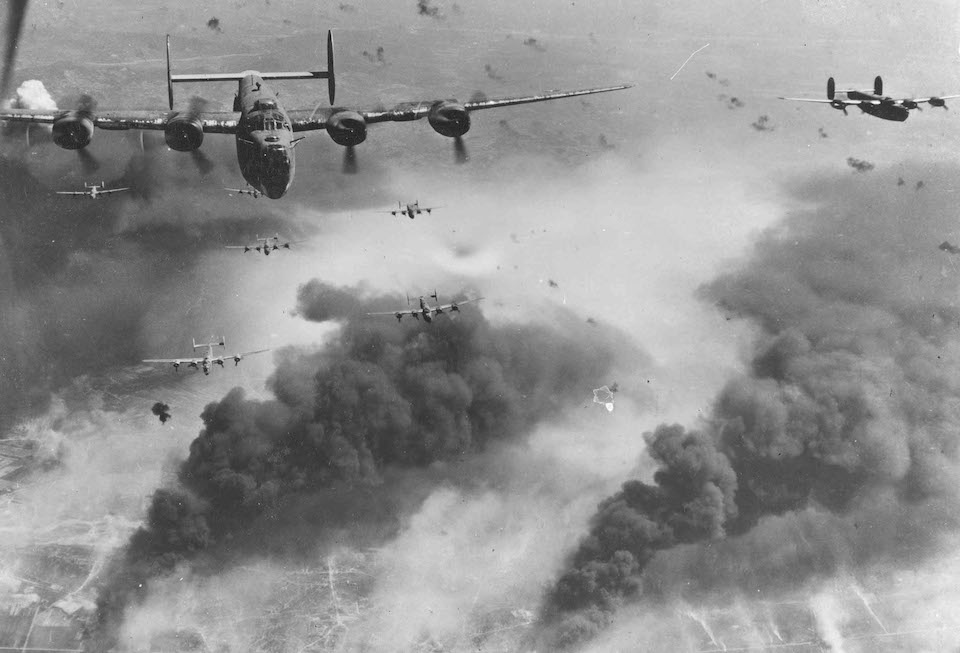Viggo Brix
(1920 - 1944)
Profile
2Lt Viggo Brix was one of the more than 30,000 Danish-Americans who served in the US armed forces during the Second World War. He was trained as pilot and served in the Fifteenth Air Force in Italy. He was killed in action, when his flak damaged B-24 crashed shortly before landing returning from a bombing mission over Ploesti.
Viggo Brix was born on 9 November 1920 in Chicago (Illinois) USA, to Christian Brix and Martha Brix (née Bøgh Hansen).[1] Brix’ father had emigrated to the USA in 1916[2] and his parents married in Chicago in 1919.[3]
Brix’ father was the publisher of the Northwest-Town Journal in 1922-34 and the publisher and editor of the Danish newspaper the Danish Times (Danske Tidende) in Chicago until 1952, when the journal merged with Den Danske Pioneer in 1952. The family lived in Denmark run 1934-38. During the Second World War, Brix father served in the Office of Strategic Services and, from May to October 1944, he served overseas.[4]
Brix worked as a typographer in his father’s printing office before the war.[5]
Brix enlisted in the US Army on 26 November 1943 in Chicago. He trained as pilot and served overseas from March 1944.

The Oil Campaign
The Mediterranean Allied Strategic Air Force was formed in late 1943 and comprised of USAAF’s newly created Fifteenth Air Force and the RAF’s 205 Group, who were operating as day and night bomber formations respectively.
From bases in the planes around Foggia, the bombers carried out operations over most parts of Southern Europe.[6] The primary target for the Strategic Air Force was the Romanian oil fields on which Germany was heavily dependent.
The first major attack on Ploesti had been carried out on 1 August 1944 by heavy bombers of the USAAF’s Eighth and Ninth Air Forces from bases in the Benghazi area in Libya (Operation Tidal Wave). The operation was considered a success in spite of heavy losses.
The Fifteenth Air Force began to mount major attacks on Ploesti—the target most often associated with the campaign—on 5 April 1944. By that time the Air Force had moved to Southern Italy where it operated from based around Foggia.[7]
The seventh (and last) trip to Ploesti
Brix and the rest of the crew had arrived in Italy in March 1944. They were assigned to 449th Bomb Group, 719th Bomb Squadron and flew thirty-five operations together and with this squadron during the following months. They flew their first operation to Ploesti on 5 April 1944, when twenty-seven B-24s took off to bomb the Marshalling Yards.
On 18 August 1944, the Brix’ took off on the seventh operation for Ploesti. He was flying as co-pilot. Twenty-three of twenty-eight aircraft dispatched reached the target and bombed from 23,500 to 24,500 feet. The aircraft—a B-24 H recently assigned to the crew—was hit by flak numerous times over the target. Most of the vertical stabilizers on the left side was shot off and there were holes all over the aircraft. Capt. Henry N. Watson, the pilot, lost control of the aircraft and lost several thousand feet of altitude. He was able to regain control of the aircraft, but just before the aircraft reached Grottaglie Air Field #3 engine stopped and the pilot was unable to control the aircraft. When the pilot rang the bailout alarm, the aircraft was flying at an altitude of only 1,500 feet. The crew tried to open the bomb bay doors to escape, but as the failed engine provided the hydraulic power which operated the doors. Capt. Watson and Lt. Brix remained in the seats to try to get the aircraft under control until it crashed to the ground. They were only a mile from the base. Six members of the crew including Brix was killed in action, and four were severely injured in the crash.[8]
Endnotes
[1] Ancestry: Cook County, Illinois Birth Index, 1916-1935.
[2] Ancestry: New York Passenger Lists, 1820-1957.
[3] Ancestry: Cook County, Illinois Marriage Indexes, 1912-1942.
[4] Kraks Blå Bog 1957.
[5] ‘Faldet på Ærens Mark’, Nordlyset, 14 Sep. 1944.
[6] Granfield, Bombers Over Sand and Snow (2011).
[7] Cooke and Nesbit, Target: Hitler’s Oil (1985), pp. 81-107.
[8] 449th Bomb Group Association (1989). “Grottaglie, and home” : a history of the 449th Bomb Group, Forty-seventh Wing, Fifteenth Air Force : a group history, pp. 76-77.